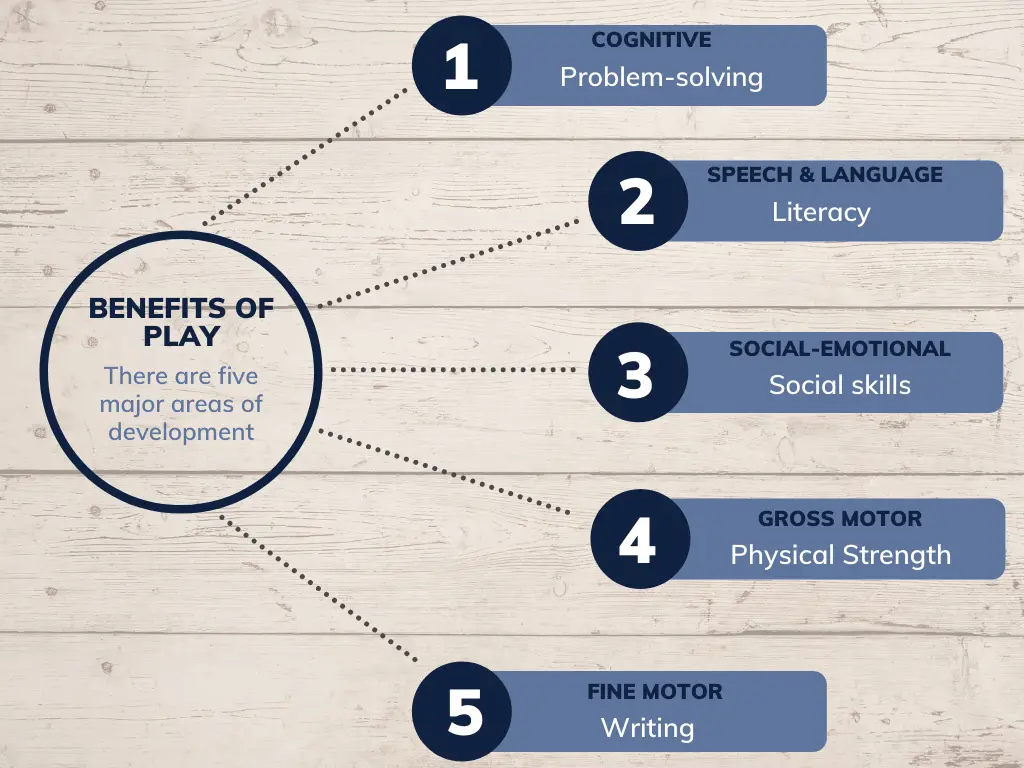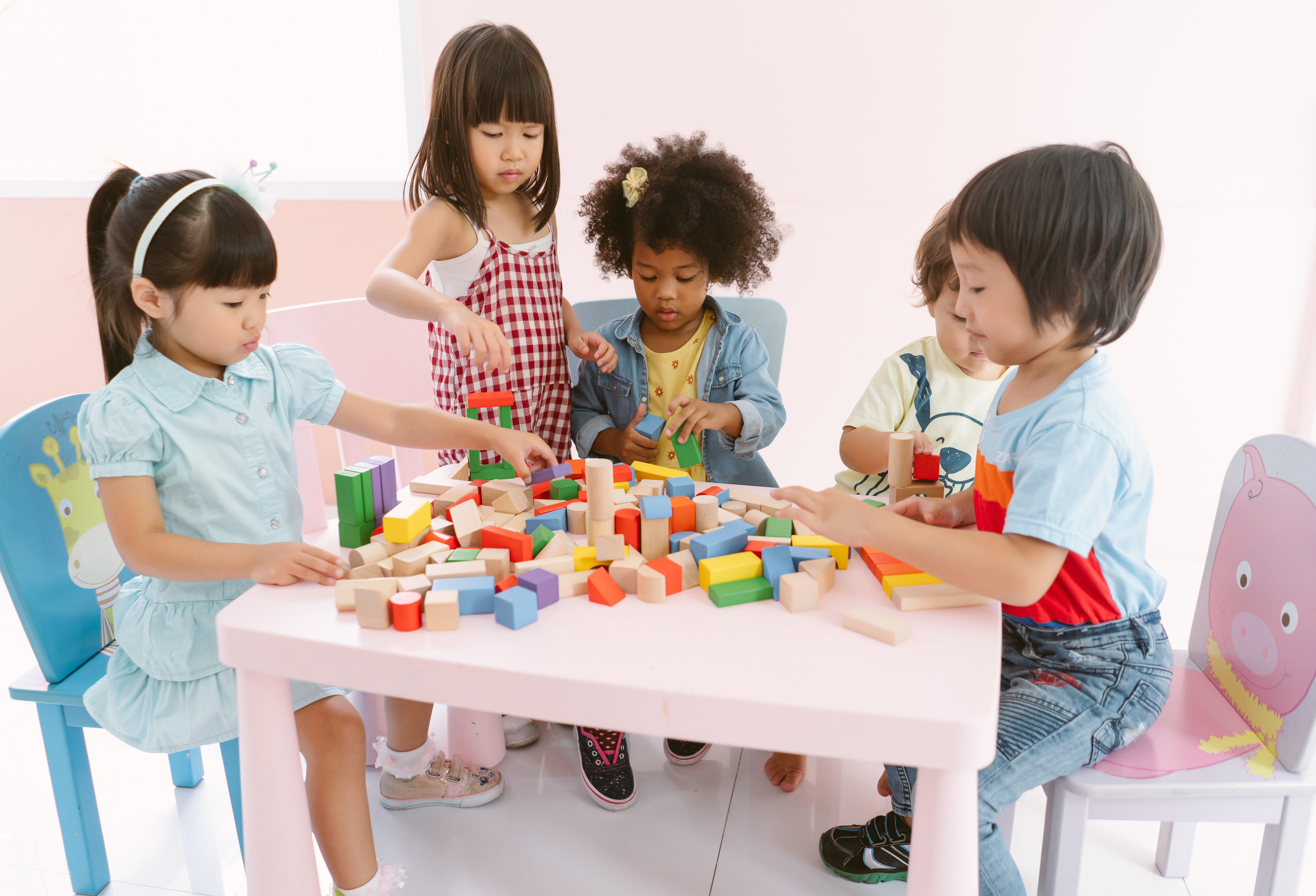There are many different ways to lead children into play. There are also tons of benefits to playing. Situations typically control adults’ level of involvement and influence how we play with our kids. Understanding the different types of play, the benefits of play, and other kinds of activities will help you make the right choices for your child.
Teach children to play by initiating a type of play that is familiar. Play alongside them for a certain period and introduce new concepts before departing, or stay for the duration of the activity. Use genuine communication and try actively listening to learn more about their motives.
This post will discuss the different benefits of play and the five areas of child development. I’ll explain the styles of play, ways to lead a child to play, and the importance of playing with kids. I’ll provide various benefits of independent play and ways to get your child to play independently.

What are the Benefits of Play?
Why is play so important for children? There are many reasons that play is critical for human development. The benefits of play are endless, and tons of educators, doctors, and parents communicate the value of play for the brain and body. There are five major areas of development that strengthen when children play.
There are five main areas of child development, and these areas are often what educators consider when planning activities for groups of children.
They are cognitive, speech and language, social-emotional, fine motor, and gross motor. Here is a bulleted list of some of the benefits of play. There is also a chart of the five developmental areas are where some of the skills may lie. Some skills overlap and benefit other areas of development. The development of one influences the growth in other areas (Gestwicki, 2007). Can you decide which skills fall under each developmental area?
Gross motor development is the strengthening of large muscles in our legs and arms. Fine motor is the development of small muscles in our hands and wrists. Both are kinds of physical development.

© 2022 Copyright Mission Momplex
| Cause and effect | Skill building | Empathy | Jumping | Drawing |
| Imagination | Social skills | Problem-solving | Throwing | Clapping |
| Personal awareness | Communication | Non-verbal communication | Running | Cutting |
| Body autonomy | Story-telling | Active listening | Hopping | Handwriting |
| Critical thinking | Joke-telling | Cooperation | Balancing | Grasping |
| Creativity | Sequencing | Expression | Stretching | Buttoning |
| Memory | Reading | Affection | Lifting | Building |
| Independence | Listening | Emotional Intelligence | Kicking | Pressing |
| Self-esteem | Responding | Decision-making | Catching | Stringing |
© 2022 Copyright Mission Momplex
What are the Different Kinds of Play?
The following 12 kinds of play come from the National Association for the Education of Young Children (NAEYC). NAEYC is a great resource and one that I have used for many years. Working in centers that followed the rules of NAEYC helped me internalize a lot of the methods and practices that they recommend. They only have children’s best interests at heart and know their stuff. I recommend checking out this website to learn more.
- Self-directed
- Guided
- Solitary
- Parallel
- Social
- Cooperative
- Onlooker
- Object
- Fantasy
- Physical
- Constructive
- Games with rules
How to Lead a Child to Play?
The different kinds of play listed above are dependent on the adult’s level of involvement, the setting, temperaments, and materials on hand. Check out this article on child-led play, adult-initiated play, and adult-led play.
Child-led Play
Follow your child’s lead. You can lead a child to play by first deciding whether or not you have time to play. Independent play is appropriate if they are already engaged in something and seem fine without adult assistance. Child-led play could also be when a child interacts with the parent or caregiver to take on a more dominant role. The child might want to control the rules, decide your part in a game or activity, or require your role to be silly or foolish.
Play With Them
Play with them if time allows and stay engaged for as long as possible. Children release anxiety when they feel comforted by an adult’s long-term presence (Gestwicki, 2007). They learn to ask questions and remain present for long periods. Play alongside them if they aren’t telling you what to do and incorporate new materials or concepts one at a time. This article has some tips on playing with children.
Adult-initiated Play
Play with them for short periods to get them engaged by trying adult-initiated play. During adult-initiated play, the caregiver prompts the child with an idea, activity, or material and eventually departs. The adult will play for a short time while incorporating gentle departure reminders. Once the child is engaged, the adult leaves to continue responsibilities.
Adult-led Play
If you have decided to play with them for an extended period and want to control the activity, this is called adult-led play. Adult-led play is a type of play that involves cooperation, involvement, and rule-following. An adult usually sets the rules because there are groups of children, safety precautions, and possibly assessments.
Senses
Teach children how to engage in their senses and prompt them to use different parts of their bodies. Show them to use their nose when they are outside in the garden or kick their feet if they want to swing higher. Follow your child’s lead to encourage them to use parts of their body that feel comfortable or need strengthening.
Active Listening
Sometimes children want to process their goals. Active listening is valuable when a child seems ambivalent but has some ideas. The child likely needs to talk about an idea they have and the procedure for execution. They may be worried about certain elements and require approval from an adult if unsure. Listen to your child and clarify any issues you may have with their activity. Let them talk to you and guide them to find the materials they need. If it is an inappropriate time or setting, discuss a different day of the week or the location that will allow them to process their goal.
Ask Questions
Stay curious and ask questions. Lead a child into play by initiating dialogue and encouraging them to be involved in complex play by asking questions to spark their imagination. Incorporate the senses and teach them that learning is a whole-body experience.
Do you hear that tapping? Is that a squirrel or a woodpecker?
Why does my nose itch when I scrape this candle?
Why do my legs pound after a bike ride?

Importance of Playing With Children
Cognitive: Being present and engaged during play gives children a sense of security, decreasing stress. Kids tend to mimic adults to strengthen cognitive skills (see the list above), and mimicking adult patterns introduces new themes and behaviors. They learn to think critically, which helps them succeed at tasks and boosts self-esteem.
Speech and language: Children develop language skills when they play with other kids and adults. They learn to make jokes, create stories, and sequence their day or character schedules. They learn to communicate effectively to get what they want as they think creatively. Children build their activities and interests based on what adults introduce and then develop new ideas when they make meaning of the existing concepts.
Social-emotional: Kids learn to respond to non-verbal cues and develop empathy for characters in books or during dramatic play. They learn to memorize and repeat repetitive actions and build on previously introduced social concepts. They learn to listen, cooperate, laugh, and express themselves. Playing with kids teaches them about their own emotional intelligence and the emotions of others.
Gross motor: The development of large muscles is a significant play component. When kids engage in gross motor development through running, jumping, and bouncing, they prepare themselves for their future responsibilities. Have you ever gone to an amusement park, and your 7-year-old didn’t want to walk? Everyday play gives children the opportunity to strengthen the neglected muscles and strengthen those that support their daily tasks.
Fine motor: Children develop their writing skills by strengthening their tiny muscles. They build, stack, grasp, and pinch, which helps them achieve a goal. Practicing with materials like glue, sand, and scissors help when they are pressured to get dressed and brush their teeth. As children play with objects and materials, they learn that the development of muscles assists with their day-to-day responsibilities.
How Do You Teach Children to Play Independently?
Lead a child to play independently by initiating play. Start with short periods and increase independent play slowly. Make sure that your child is aware of accessible activities, and reassure your presence. Check out this article that discusses independent playtime and different ways to get young children to play independently. I also wrote an article about the parent-initiated play.
Importance of Independent Play
Independent play teaches children to value their ideas and personal space. They learn to develop skills that help them get out of situations in the future because they don’t have anyone around telling them what to do. They develop autonomy and confidence in their personal learning style.
Conclusion
We have covered a lot here! We talked about the five different areas of development and the benefits of play. There are 12 different kinds of play according to NAEYC and other methods for leading children to play. There are benefits to independent play and ways to encourage children to play solo. It is important to remember that parent-initiated play is critical, as is actively playing for long periods.
Sources
- 5 Main Areas of Child Development – Skoolzy
- 11 Tips for Playing With Children– adult-led, child-led – Mission Momplex
- What is Adult-Led Play? – Mission Momplex
- Adult-led play & child-led play– differences, benefits, balance – Mission Momplex
- Gestwicki, C. Developmentally appropriate practice. Curriculum & Development in Early Education. New York: Thomson Delmar Learning, 2007.
- Principles of Child Development and Learning and Implications That Inform Practice | NAEYC
- What Is Independent Playtime? – Mission Momplex
